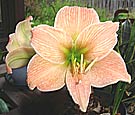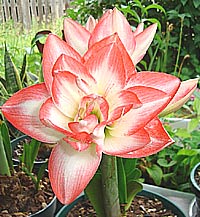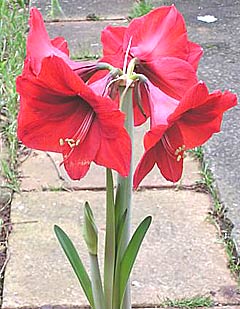Hippeastrum bulbs - Care and cultivation
VARIETIES OF HIPPEASTRUM
Alfresco
Almalfi
Blossom Peacock
Candy Cane
Cinderella
Cocktail
Crystal Palace
Elvas
Fairytale
First Love
Green Goddess
Hercules
Honeymoon
Hope
Lemon Lime
Peacock
Pink Floyd
Pizzazz
Princess Carnival
Queen of Hearts
Red Charm
Royal Velvet
Salmon Master
Sweet Kiss
Wedding Dance
White Nymph

PLANT SOCIETIES
HIPPEASTRUM - Amaryllidaceae
 Hippeastrum
are often incorrectly called Amaryllis - although they belong to the same
family they are quite different plants.
Hippeastrum
are often incorrectly called Amaryllis - although they belong to the same
family they are quite different plants.
Very few of the original Hippeastrum species are available now, as plant breeders have concentrated on developing a wide range of Hippeastrum hybrids.
The Hippeastrum bulb has a perfect embryo flower already formed.
All that need be done in the first year is to pot the bulb and care for it until it flowers.
After that some skill is required to make sure it blooms in subsequent years.
Hippeastrum have a dormant winter period when the leaves dry up and are shed, and so are usually sold as dry bulbs.
The leaves usually emerge in early spring and the flower stalk when fully developed can be up to 18 inches long.
Large Hippeastrum bulbs may produce two flower stems, one following the other.
Each stem carries two, three or four blooms. and in some types every bloom can be up to 7 inches across.
These flowers can last for two to three weeks.
POTTING HIPPEASTRUM
Hippeastrum bulbs can be planted from October until late April. Starts flowering 6-10 weeks after you plant it.
Its best to use a rich soil –based potting mixture with plenty of clay pot fragments at the bottom of the pot for good drainage.
Half bury the bulbs leaving the neck and shoulders clear of the potting mixture.
Set the bulbs singly in 7 inch pots and firm the mixture down around the bulb and any existing roots.
Like all amaryllids, Hippeastrums, dislike root disturbance, and flower best when left alone. After about three or four years re-pot completely. Shake the bulb free of the old mixture and replant.
Place the pot in a warm location with light. Normal room temperatures of up to 65F -20c but no higher will encourage fast growth and bring hippeastrums into early bloom. Too much heat will shorten the life of the flowers.
Too little light when a plant is in active growth results in elongated leaves and in no flowers the following year.
So a continuous position in bright sun light from the time the flowers fade until mid-fall will contribute more than any other factor to subsequent flowering.
WATERING HIPPEASTRUM BULBS
Water newly potted bulbs sparingly, just enough to keep the potting mixture
moist.
When new growth appears and roots have developed water moderately, letting the top half of the mixture dry out between waterings .
When in full growth keep the potting mixture constantly moist.
CARE OF HIPPEASTRUM BULBS
Once flowering is finished and a little care is taken the bulb will flower again next year.
Remove the old shrivelled flowers to let the leaves develop. Add fertilizer .
Reduce watering and fertilizing in September and stop completely in October.
After watering stops, the foliage will become yellow and wither away.
Let the bulb rest in a cool dark place for a few months keeping the potting mixture completely dry throughout the rest period.
Plant the bulb again in January, and it should bloom again in March (remember to remove the dried roots and old soil before planting)
PROPAGATION OF HIPPEASTRUM
Around the base of the parent bulb you will find small bulbs and these can be detached when they are about an inch to inch and a half across.
Keep as much root as possible attached to them.
You can treat them the same as a mature bulb but keep moving them into slightly larger pots each year until they are three to three and a half inches across.
This is the flowering size.
Hippeastrum can also be grown from seed.
